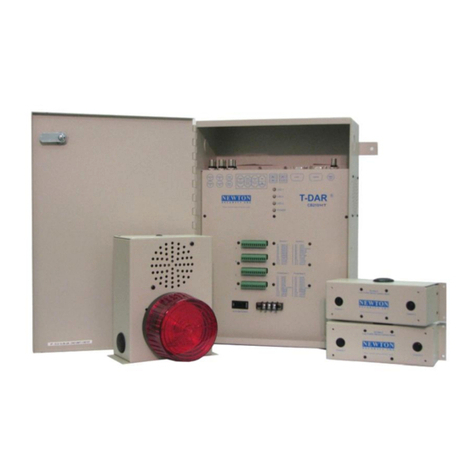
3
3. TIPS FOR A SUCCESSFUL T-DAR INSTALLATION
To ensure the most accurate detection, it is crucial that the final internal dimensions of a T-DAR-equipped
mantrap adhere to the measurements that an end-user has provided to Newton Security. The design,
performance and price of this system are based upon those specific characteristics.
Mantrap Location
Locate the mantrap as far away from sunlight as possible. Changes in ambient light levels (day-to-night)
in the mantrap may significantly increase false detection and false alarms.
Mantrap Construction
For optimum results the mantrap should be of opaque, solid wall construction.
If a glass wall is used for the installation, Newton Security recommends:
There should be no indirect sunlight in the mantrap. If the potential exists for sunlight in the
environment, do the following test on a bright day when there is full sunlight exposure:
oTurn off all lighting fixtures in the mantrap and in the surrounding area.
oIf you can read this manual or similar text in the resulting available light, there may be
too much sunlight for optimum performance.
oPoint a light meter at the source of the sunlight; it should be less than 10LUX.
Any direct sunlight in the mantrap will cause erratic performance and must be avoided.
For the most consistent performance, use the least amount of glass possible, for the mantrap
walls. Avoid using glass doors in the mantrap, as people standing outside the door (waiting to
use the mantrap) may be detected by the T-DAR cameras.
Avoid using fully glassed walls next to a high traffic area, as people may be detected outside
the mantrap wall.
oWe suggest installing two sections of glass in the wall, running the length of the
mantrap if necessary.
oOne section may be placed higher than five feet above the floor, with the other
section below three feet from the floor.
oThis results in an opaque section, between three and five feet above the floor, and
will prevent the cameras from detecting a person standing on the other side of the
glass.
Mantrap Height
The minimum camera height for proper tracking of the T-DAR cameras is 2600mm (8.5 ft).
Persons taller than 6.3 ft. (1.9m) may receive higher false alarm rates in mantraps with
camera heights lower than 2600mm (8.5 ft).
For ceilings between 2410mm (7.9 ft) and 2600m (8.5ft), camera height extending kits are
available.
For low false alarm rates, mount the camera head at 2750mm (9ft) or higher.
Mantrap Size
The mantrap size is limited by the height and viewing angle of the camera heads. The limits specified
below are rigid and cannot be exceeded. Exceeding the two-head mantrap size limitations will leave a
significant gap in tracking, and security. If the mantrap is built over the specified size, a larger three or
four head T-DAR system should be purchased.
The maximum length of a mantrap with cameras lower than 2740mm (9ft) is 2740mm (9ft).
The maximum width with cameras lower than 2740mm (9ft) is 1450mm (4.75ft).
The maximum length of a mantrap with cameras above 2740mm (9ft) is 3000mm (10ft).
The maximum width of a mantrap with cameras above 2740mm (9 ft) is 1500mm (5ft).




























